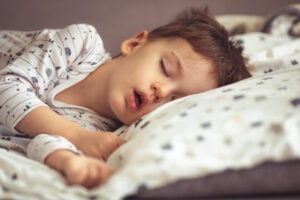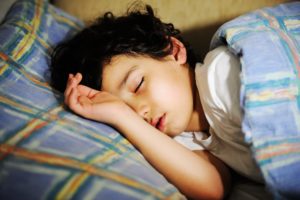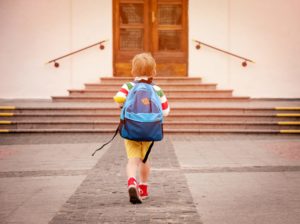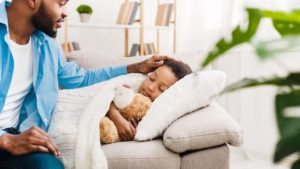When you buy through our links, we may earn a commission. Products or services may be offered by an affiliated entity. Learn more.
Sleep Strategies for Kids
It’s well known that proper sleep is essential to a child’s development. But for the 15–25 percent of kids and teens who struggle to fall asleep or stay asleep, getting adequate rest can feel daunting.
Helpless parents may begin to dread bedtime, unsure how to help their little one nod off and sleep soundly. Sleeping pills, commonly turned to for adult insomnia, are discouraged in children. Pharmaceutical sleep aids can have significant risk of side effects in children, and therefore should only be used under the careful guidance of a doctor. Vitamins and supplements may be marked for children, but the FDA doesn’t monitor them the same way they do drugs, so we recommend consulting a doctor before trying these.
Fortunately, specific behavioral changes and adjustments to the sleep environment will help most children with insomnia. We’ve compiled the top tips that are proven to help kids sleep. The recommendations outlined here are best suited for toddlers through early adolescence. Both babies and teens will have specific considerations of their own.
These lists may seem long, but you don’t need to implement them all at once. It’s better to focus on trying a few small changes, giving them time to work, and then adjusting your approach based on how your child responds.
Keep in mind that every child’s sleep needs will vary based on their age, genetics, and cultural differences. Therefore, not all approaches will work equally well for all children, and there can be an element of trial and error. However, your patience will be rewarded in time as your little one learns to fall asleep quickly on their own and keep sleeping soundly through the night.
Help Your Child Sleep Better With Pediatric Sleep Coaching

our partner at sleepdoctor.com
Learn More“Life-changing! My anxiety about my son’s sleeping habits were immediately reduced after talking to Sara. She went above and beyond to tailor a schedule to our goals, answer our questions, keep us on track, and check in to encourage us when we just thought we couldn’t do it anymore.”
Rachael B. – Verified Customer
Sleep Hygiene for Kids
Sleep hygiene — a collection of habits and behaviors that promote good sleep — is vital for children. Many sleep struggles are caused or made worse by poor sleep hygiene. When practicing sleep hygiene, remember that consistency is key. Sleep strategies take time and repetition to be effective.
- Create a Routine: Humans are creatures of habit. A consistent bedtime routine lets your child’s body and mind know that it’s time to settle down and prepare for sleep. The actual routine can be specific to your child, but it should last around 20 minutes and consist of three to four quiet, soothing activities such as putting on PJs, brushing teeth, a warm bath, and reading. Bedtime routines provide children with a sense of familiarity and comfort, which acts in direct opposition to the uncertainty of insomnia.
- Set a Bedtime: A sleep schedule works with your child’s natural biological clock to promote dozing off with regularity. Bedtimes are most useful when they’re consistent, so try to keep the same bedtime on weekends as on school nights. Altering bedtimes during the weekend will make it more difficult for kids to maintain their normal weekday schedules.
- Implement a Screen Curfew: The ubiquity of screens makes this rule hard to implement, but it’s well worth it. Mobile devices, TVs, and tablets emit a type of blue light that suppresses melatonin, a hormone that promotes sleep. Children may be particularly vulnerable to the effects of light from screens. Screen time also stimulates the brain, making it harder to wind down for sleep. Electronic devices should be kept out of the bedroom and ideally not used within one hour of bedtime. Consider using the family media plan created by the American Academy of Pediatrics.
- Get Exercise: Physical activity is proven to help people of all ages fall asleep faster and stay asleep . Most children need at least one hour of exercise per day. Just make sure to avoid vigorous activity within two hours of bedtime. Otherwise, your child may feel wound-up and find it harder to fall asleep.
- Avoid Scary or Violent Content: Feeling scared or worried is a common reason kids can’t sleep. So it’s no wonder that scary or violent movies, TV, video games, and even books in the evening are linked to sleep disturbances in children. If your kiddo likes the gory or spooky stuff, save it for the daytime.
- Nix Caffeine: This is a no brainer. Caffeine is a stimulant that can both make it harder to fall asleep and reduce the quality of sleep. In addition to the usual suspects like soda, coffee, and energy drinks, watch out for more discreet sources like tea, decaf coffee (which still has trace amounts of caffeine) and chocolate. Even small amounts of caffeine can have a big impact in a little body. Don’t let your child consume caffeine within six hours of bedtime , or preferably, avoid it all together.
- Don’t Sleep With a Pet: While it’s tempting for tots to snuggle Fido in bed, a pet’s movements and noises during the night can awaken them from a peaceful slumber. Try having your furry family member sleep outside of your child’s bedroom for a few nights to see if that helps. To make the transition easier, include saying goodnight to pets in the bedtime routine.
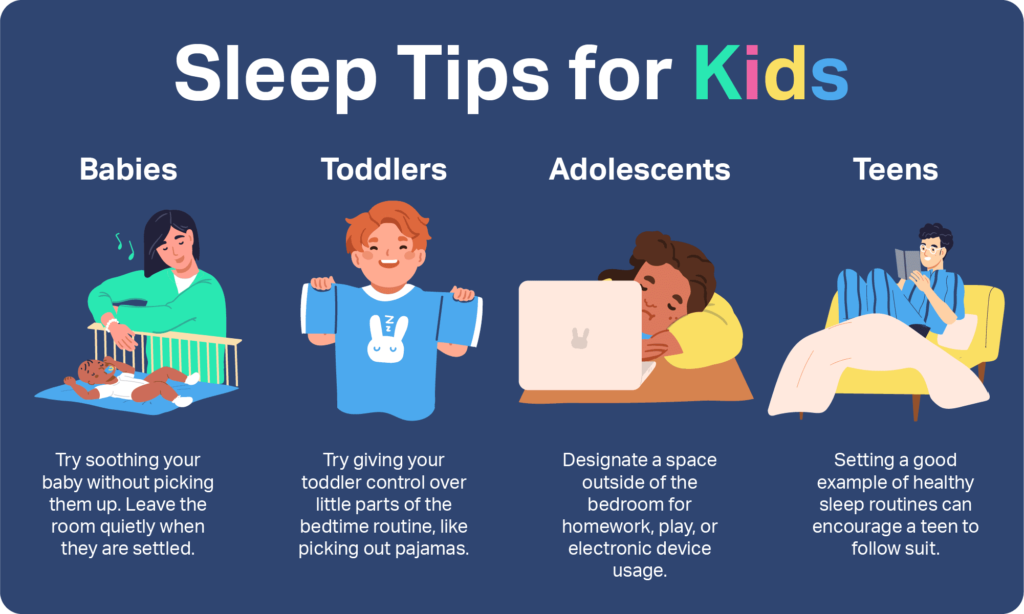
Making a Sleepy Bedroom
Optimizing your child’s bedroom is an integral part of inducing quick and seamless shuteye. People with insomnia are more likely to be distracted by an uncomfortable bedroom , which makes sleep even harder. These tips can help you create the perfect sleep setup for your little one:
- Room Temperature: The body and brain both cool down in preparation for sleep, and this can be disrupted by a stuffy bedroom. To avoid this, try to keep the thermostat around 65 degrees.
- Noise: Research suggests that even mild sound disturbances can affect the quality of slumber , even if the sleeper never awakens. Consider noise-blocking curtains to cut down on street noise. You can also use a fan or white noise machine to drown out unpredictable or distracting sounds.
- Light Level: Start dimming indoor lights as bedtime approaches, and keep your child’s bedroom as dark as possible. This promotes healthy levels of melatonin and supports your child’s natural biological clock . If your child is afraid of the dark, a small nightlight is okay.
- Soothing smells: Calming scents like lavender can have mild sedative effects. You might try using essential oils, a room diffuser, or dried potpourri sachet to provide a soothing, sleep-inducing smell.

Overcoming Bedtime Worry
Unfortunately, childhood anxiety is steadily rising . Stress is known to disrupt sleep in all ages, so anything that can reduce worrying before bed is helpful. Help your child learn to manage their concerns with these tactics:
- Write In a Journal: Encourage your child to get their anxious thoughts out of their head and onto paper. It can also help for them to write about the good things that happened in the day. Focusing on the positive will help children feel more secure.
- Mindfulness Exercises: Mindfulness exercises like meditation are proven to calm the nervous system and decrease stress hormones . There are many kid-friendly meditations that parents and children can do together. These often consist of simple breathing techniques, body awareness, or guided imagery. Look to books, tapes, and even smartphone apps for ideas.
- Create a Worry Time: It’s okay to discuss worries, just not at bedtime. Set aside a specific time during the day for your children to discuss their concerns and how to cope with them. This can free children of the need to dwell on worries before bed.
The Art of the Room Check
It’s normal for even the best little sleepers to awaken from slumber and ask for a parent. When your child cries out for you, it’s okay to tend to them. However, you should do so with intention. This is not the time to give in to demands, as doing so can increase stimulation and make it harder to fall asleep. Fulfilling your child’s every request can also reinforce an unhelpful pattern of relying on parental assistance for sleep.
Instead, keep the checks short and simple. The point is to provide your child with reassurance that they’re safe and cared for, while still fostering their ability to self-soothe and sleep on their own. Some parents may even wait a few seconds before answering a call so that their child has the opportunity to fall back asleep on their own.
If you have any doubt over whether your child’s nighttime checks are appropriate, consult your child’s doctor for guidance.
When To See the Doctor
If your child continues to have trouble sleeping despite your best efforts, it may be time to check in with their pediatrician. Although uncommon, there can be more serious causes of childhood insomnia, such as childhood sleep apnea or restless leg syndrome.
Any of these reasons are cause to involve a doctor:
- Significant daytime sleepiness
- Frequent or severe snoring or other abnormal breathing during sleep
- Suspected psychological or developmental condition
- Considering medications or supplements to aid in sleep
For a couple of weeks before the doctor appointment, it can help to keep a sleep diary. This is a nightly recording of your child’s bed time, nap times, sleep length, and activities. A sleep diary helps to identify patterns and possible problems to address.

Still have questions? Ask our community!
Join our Sleep Care Community — a trusted hub of sleep health professionals, product specialists, and people just like you. Whether you need expert sleep advice for your insomnia or you’re searching for the perfect mattress, we’ve got you covered. Get personalized guidance from the experts who know sleep best.
References
18 Sources
-
Esparham, A. (2020, January 2). Melatonin and Children’s Sleep. HealthyChildren.Org.
https://www.healthychildren.org/English/healthy-living/sleep/Pages/Melatonin-and-Childrens-Sleep.aspx -
Mindell, J. A., Li, A. M., Sadeh, A., Kwon, R., & Goh, D. Y. (2015). Bedtime routines for young children: a dose-dependent association with sleep outcomes. Sleep, 38(5), 717–722.
https://pubmed.ncbi.nlm.nih.gov/25325483/ -
LeBourgeois, M. K., Hale, L., Chang, A. M., Akacem, L. D., Montgomery-Downs, H. E., & Buxton, O. M. (2017). Digital media and sleep in childhood and adolescence. Pediatrics, 140(Suppl 2), S92–S96.
https://pubmed.ncbi.nlm.nih.gov/29093040/ -
Family Media Use Plan. (n.d.)., Retrieved September 23, 2020, from
https://www.healthychildren.org/English/media/Pages/default.aspx -
A.D.A.M. Medical Encyclopedia. (2017, August 30). Benefits of Exercise., Retrieved August 30, 2020, from
https://medlineplus.gov/benefitsofexercise.html -
A.D.A.M. Medical Encyclopedia. (2017, August 30). How Much Exercise Do I Need?., Retrieved August 30, 2020, from
https://medlineplus.gov/howmuchexercisedoineed.html -
Garrison, M. M., Liekweg, K., & Christakis, D. A. (2011). Media use and child sleep: the impact of content, timing, and environment. Pediatrics, 128(1), 29–35.
https://pubmed.ncbi.nlm.nih.gov/21708803/ -
Temple J. L. (2019). Review: Trends, Safety, and Recommendations for Caffeine Use in Children and Adolescents. Journal of the American Academy of Child and Adolescent Psychiatry, 58(1), 36–45.
https://linkinghub.elsevier.com/retrieve/pii/S0890856718318847 -
Drake, C., Roehrs, T., Shambroom, J., & Roth, T. (2013). Caffeine effects on sleep taken 0, 3, or 6 hours before going to bed. Journal of clinical sleep medicine : JCSM : official publication of the American Academy of Sleep Medicine, 9(11), 1195–1200.
https://pubmed.ncbi.nlm.nih.gov/24235903/ -
Narisawa H. (2013). Anxiety and its related factors at bedtime are associated with difficulty in falling asleep. The Tohoku journal of experimental medicine, 231(1), 37–43.
https://www.jstage.jst.go.jp/article/tjem/231/1/231_37/_article -
Harding, E. C., Franks, N. P., & Wisden, W. (2019). The temperature dependence of sleep. Frontiers in Neuroscience, 13, 336.
https://pubmed.ncbi.nlm.nih.gov/31105512/ -
Van Der Werf, Y. D., Altena, E., Schoonheim, M. M., Sanz-Arigita, E. J., Vis, J. C., De Rijke, W., & Van Someren, E. J. (2009). Sleep benefits subsequent hippocampal functioning. Nature neuroscience, 12(2), 122–123.
http://www.nature.com/articles/nn.2253 -
Burgess, H. J., & Molina, T. A. (2014). Home lighting before usual bedtime impacts circadian timing: a field study. Photochemistry and photobiology, 90(3), 723–726.
https://pubmed.ncbi.nlm.nih.gov/24918238/ -
Gooley, J. J., Chamberlain, K., Smith, K. A., Khalsa, S. B., Rajaratnam, S. M., Van Reen, E., Zeitzer, J. M., Czeisler, C. A., & Lockley, S. W. (2011). Exposure to room light before bedtime suppresses melatonin onset and shortens melatonin duration in humans. The Journal of Clinical Endocrinology and Metabolism, 96(3), E463–E472.
https://pubmed.ncbi.nlm.nih.gov/21193540/ -
Koulivand, P. H., Khaleghi Ghadiri, M., & Gorji, A. (2013). Lavender and the nervous system. Evidence-based complementary and alternative medicine : eCAM, 2013, 681304.
https://www.hindawi.com/journals/ecam/2013/681304/ -
National Center on Birth Defects and Developmental Disabilities. (2020, June 15). Data and Statistics on Children’s Mental Health. Centers for Disease Control and Prevention.
https://www.cdc.gov/children-mental-health/data-research/index.html -
Anxiety and Depression Association of America. (n.d.). Sleep Disorders., Retrieved August 31, 2020, from
https://adaa.org/understanding-anxiety/related-illnesses/sleep-disorders -
Ong, J. C., Manber, R., Segal, Z., Xia, Y., Shapiro, S., & Wyatt, J. K. (2014). A randomized controlled trial of mindfulness meditation for chronic insomnia. Sleep, 37(9), 1553–1563.
https://pubmed.ncbi.nlm.nih.gov/25142566/











